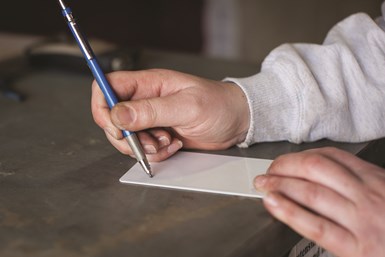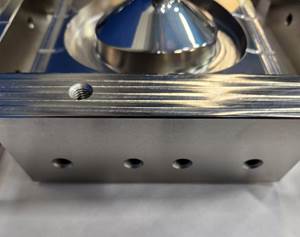Proper Testing of a Powder Coat Finish
Manufacturer shows how it performs extensive tests on powder coated medical carts.

HUI uses powder coating on its custom medical carts.
Many of the custom medical carts that HUI manufactures have a powder coated finish, and as with any finish applied to any product, the powder coating we apply needs to be tested to ensure that the finish is going to last.
The following is a description of some of the tests our company commonly uses to validate that the powder coated finishes are in tolerance, properly cured and ready to stand up to the environmental conditions your carts will be used in.
Adhesion Tests

The scratch test is performed by cutting a crosshatched grid pattern into the coating all the way down to the substrate.
Crosshatch. The crosshatch test is designed to test the adhesion of the powder coating to the metal substrate. It’s performed by cutting a crosshatched grid pattern into the coating all the way down to the substrate. A special pressure-sensitive tape is then applied to the crosshatched area and then removed quickly at close to a 180-degree angle. The area is then inspected to see if any of the coating is lifted away from the substrate.

Mandrel Bend
Mandrel Bend. This test checks the elasticity and the adhesion of the powder coating to the substrate. A cured sample panel is placed into a small device that bends the panel over onto itself. The coating should not crack or lose adhesion in the area of the bend.

The sample panel is placed into the testing machine where a ball is dropped onto it to produce a deep depression.
Impact Test. Similar to the mandrel bend test, the impact test deforms a sample panel in order to test the adhesion of the powder coating. The sample panel is placed into the testing machine where a ball is dropped onto it to produce a deep depression. Here again, the powder coated finish should not crack or lose adhesion to the substrate in the impacted area.
Durability Test
Salt Spray Test. This is a corrosion resistance test and is performed by scribing a line or “X” onto the surface of a finished powder coated panel. The panel is then placed into a chamber where a corrosive mist is applied. The panel is taken out of the chamber at set time intervals and the distance that the coating has “crept” away from the scribed line is measured and recorded. If the amount of creep does not exceed the allowable distance in the predetermined time intervals, the panel passes the test.
Cure and Finish Tests
MEK Rub Test. This test is used to ensure proper cure of the powder coating to the substrate. Methyl ethyl ketone (MEK) is applied to a surface of the part or panel and then rubbed with a cotton swab. The area is observed for degradation or loss of paint adhesion to the substrate.
Color Match. Once our powder coated parts have cured and cooled off after being in the bake oven, the finished color is compared to an approved color chip sample. This visual inspection is the most common and quickest method to check the color. If there is a variance, the color can then be measured using a photo spectrometer to provide data that can be compared to a known sample and tolerance range for the specific color.

Gloss Test – The gloss of a finished powder coated part is validated by measuring the specular reflection of its surface.
Gloss Measurement. The gloss of a finished powder coated part is validated by measuring the specular reflection of its surface. This test is performed using a gloss meter, which shines a light onto the surface of the part at a fixed angle, then measures the amount of light reflected off it. If the measurement is out of tolerance, it may be an indication that the powder coating has not cured properly.
Coating Thickness Test
To achieve the best coating performance, each powder has a specified thickness range it must be applied within. HUI takes this measurement at two different stages during the powder coating process. Our powder room technician uses a dry mil gage to take the first measurement right after the part comes out of the powder booth. The technician can then relay to the painters whether they’re applying the correct amount of powder onto the parts.
This immediate feedback is beneficial because it catches possible lightly or heavily coated parts before the powder is cured and it’s too late to fix the problem. After the parts have cured, the mil thickness is checked again to verify the coating thickness is within tolerance for the specified powder.

At HUI, we validate our painting processes to ensure that a medical cart’s finish stays beautiful and durable, so that customers receive the finish they desire.
Greg Binversie is an engineer with HUI Manufacturing. For information, visit medicalcarts.org.
Originally published in the April 2017 issue.
Related Content
Finishing High Reliability, Function Critical Parts
From safety critical automotive and aerospace components to lifesaving medical micro-components and implantable devices, Indiana-based Electro-Spec finishes applications that require zero failure rates.
Read MorePrecision Coating Receives ISO 14001 Certification
The company says its commitment to the environment and its health led it to seek this certification.
Read MoreTop Shop Builds Original Systems for Coating Medical Devices
Engineers at Surgical Coatings in Colorado have been ingeniously developing their own equipment, automation, processes and software since this powder coater’s inception in 1995.
Read MoreEngineered Coatings Offer Improvement for Medical Device Manufacturers
Diamond electroless nickel coating provides better lubricity and improved wear resistance for molds, resulting in better quality and productivity.
Read MoreRead Next
Delivering Increased Benefits to Greenhouse Films
Baystar's Borstar technology is helping customers deliver better, more reliable production methods to greenhouse agriculture.
Read MoreA ‘Clean’ Agenda Offers Unique Presentations in Chicago
The 2024 Parts Cleaning Conference, co-located with the International Manufacturing Technology Show, includes presentations by several speakers who are new to the conference and topics that have not been covered in past editions of this event.
Read MoreEpisode 45: An Interview with Chandler Mancuso, MacDermid Envio Solutions
Chandler Mancuso, technical director with MacDermid Envio discusses updating your wastewater treatment system and implementing materials recycling solutions to increase efficiencies, control costs and reduce environmental impact.
Read More










.jpg;maxWidth=300;quality=90)










